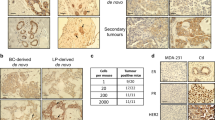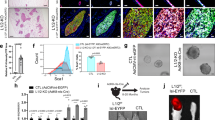Abstract
Development of strategies for prevention of breast cancer development requires an understanding of the effects of mammary oncogenes on mammary cells at early stages in neoplastic transformation. As mammary oncogenes wnt-1 and int-2 affect different signal transduction pathways, we investigated their effects on established mouse mammary epithelial cell lines (MMECLs) reflecting early stages in tumorigenesis. Normal interactions between β-catenin and E-cadherin were abrogated in all three immortalized MMECLs and the cells lacked β-catenin-mediated transactivation activity, detectable using a reporter assay, suggesting that alterations in cell adhesion may be very early events in mammary tumorigenesis. Immortalized FSK4 and EL12 cells and hyperplastic TM3 cells were stably transfected with expression vectors encoding wnt-1 or int-2 or the control vector, and drug-selected pooled cells from each line were confirmed by reverse transcription-polymerase chain reaction to express the transfected oncogene; this expression persisted in the cells analysed in vitro and in vivo. Resultant phenotypic changes depended both on the oncogene and the target mammary cell line. In FSK4 cells, expression of wnt-1 or int-2 resulted in proliferative changes in vitro, including reduced contact inhibition, increased β-catenin expression, and decreased p53 transcriptional activity, but neither oncogene conferred upon those cells the ability to produce tumors in vivo. EL12 cells were highly refractory to the effects of both oncogenes, with the only measurable changes being increased E-cadherin levels induced by both oncogenes and increased proliferation of the int-2-transfected cells in the absence of serum. Parental TM3 cells were phenotypically similar to wnt-1- or int-2-transfected FSK4 cells and displayed an increased rate of proliferation in vitro and markedly increased tumorigenicity in vivo following transfection with int-2 but not with wnt-1. These results suggest that wnt-1 signaling is redundant in the hyperplastic TM3 cells and indicate that wnt-1-induced effects in the immortalized FSK4 and EL12 cells were not sufficient to mediate a tumorigenic phenotype. This study showed that the wnt-1 and int-2 oncogenes have similar but distinguishable effects on immortalized MMECLs and that the genetic background of the mammary cells greatly influences the consequences of oncogene expression at early stages of cell transformation.
This is a preview of subscription content, access via your institution
Access options
Subscribe to this journal
Receive 50 print issues and online access
$259.00 per year
only $5.18 per issue
Buy this article
- Purchase on Springer Link
- Instant access to full article PDF
Prices may be subject to local taxes which are calculated during checkout









Similar content being viewed by others
Abbreviations
- CMV:
-
cytomegalovirus
- ECL:
-
enhanced chemiluminescence
- EGF:
-
epidermal growth factor
- FGF:
-
fibroblast growth factor
- FGFR:
-
FGF receptor
- MMECL:
-
mouse mammary epithelial cell line
- MMTV:
-
mouse mammary tumor virus
- MTT:
-
3-[4,5-dimethylthiazol-2-yl]-2,5-diphenyltetrazolium bromide
- PAGE:
-
polyacrylamide gel electrophoresis
- PBS:
-
phosphate-buffered saline
- RT–PCR:
-
reverse transcription polymerase chain reaction
- SDS:
-
sodium dodecyl sulfate
References
Aberle H, Schwartz H, Kemler R . 1996 J. Cell Biochem. 61: 514–523
Aoki M, Hecht A, Kruse U, Kemler R, Vogt PK . 1999 Proc. Natl. Acad. Sci. USA 96: 139–144
Bonnette SG, Kittrell FS, Stephens LC, Meyn RE, Medina D . 1999 Carcinogenesis 20: 1715–1720
Clevers H, van de Wetering M . 1997 Trends Genet. 13: 485–489
Coleman-Krnacik S, Rosen JM . 1994 Mol. Endocrinol. 8: 218–229
Damalas A, Ben-Ze'ev A, Simcha I, Shtutman M, Leal JF, Zhurinsky J, Geiger B, Oren M . 1999 EMBO J. 18: 3054–3063
Dickson C, Smith R, Brookes S, Peters G . 1984 Cell 37: 529–536
Dixon M, Deed R, Acland P, Moore R, Whyte A, Peters G, Dickson C . 1989 Mol. Cell. Biol. 9: 4896–4902
Donehower LA, Godley LA, Aldaz CM, Pyle R, Shi YP, Pinkel D, Gray J, Bradley A, Medina D, Varmus HE . 1995 Genes Dev. 9: 882–895
Donehower LA, Harvey M, Slagle BL, McArthur MJ, Montgomery Jr CA, Butel JS, Bradley A . 1992 Nature 356: 215–221
el Yazidi I, Boilly-Marer Y . 1995 Anticancer Res. 15: 783–790
Fioravanti L, Cappelletti V, Coradini D, Miodini P, Borsani G, Daidone MG, Di Fronzo G . 1997 Int. J. Cancer 74: 620–624
Galzie Z, Kinsella AR, Smith JA . 1997 Biochem. Cell Biol. 75: 669–685
Gavin BJ, McMahon AP . 1992 Mol. Cell. Biol. 12: 2418–2423
Hajitou A, Baramova EN, Bajou K, Noe V, Bruyneel E, Mareel M, Collette J, Foidart JM, Calberg-Bacq CM . 1998 Oncogene 17: 2059–2071
He TC, Sparks AB, Rago C, Hermeking H, Zawel L, da Costa LT, Morin PJ, Vogelstein B, Kinzler KW . 1998 Science 281: 1509–1512
Hinck L, Nelson WJ, Papkoff J . 1994 J. Cell Biol. 124: 729–741
Hollmann CA, Medina D, Butel JS . 2000 In Vitro Cell. Dev. Biol. Anim. 36: 74–76
Hsu SC, Galceran J, Grosschedl R . 1998 Mol. Cell. Biol. 18: 4807–4818
Jackson D, Bresnick J, Rosewell I, Crafton T, Poulsom R, Stamp G, Dickson C . 1997 J. Cell Sci. 110: 1261–1268
Jakobovits A, Shackleford GM, Varmus HE, Martin GR . 1986 Proc. Natl. Acad. Sci. USA 83: 7806–7810
Jansen LAM, Mesnil M, Jongen WMF . 1996 Carcinogenesis 17: 1527–1531
Jerry DJ, Ozbun MA, Kittrell FS, Lane DP, Medina D, Butel JS . 1993 Cancer Res. 53: 3374–3381
Jiang WG . 1996 Brit. J. Surg. 83: 437–446
Kern FG, McLeskey SW, Zhang L, Kurebayashi J, Liu Y, Ding IY, Kharbanda S, Chen D, Miller D, Cullen K, Paik S, Dickson RB . 1994 Breast Cancer Res. Treat. 31: 153–165
Kittrell FS, Oborn CJ, Medina D . 1992 Cancer Res. 52: 1924–1932
Klint P, Claesson-Welsh L . 1999 Front. Biosci. 4: D165–D177
Korinek V, Barker N, Morin PJ, van Wichen D, de Weger R, Kinzler KW, Vogelstein B, Clevers H . 1997 Science 275: 1784–1787
Kuhl M, Sheldahl LC, Park M, Miller JR, Moon RT . 2000 Trends Genet. 16: 279–283
Kwan H, Pecenka V, Tsukamoto A, Parslow TG, Guzman R, Lin TP, Muller WJ, Lee FS, Leder P, Varmus HE . 1992 Mol. Cell. Biol. 12: 147–154
Marsh SK, Bansal GS, Zammit C, Barnard R, Coope R, Roberts-Clarke D, Gomm JJ, Coombes RC, Johnston CL . 1999 Oncogene 18: 1053–1060
McLeskey SW, Zhang L, Kharbanda S, Kurebayashi J, Lippman ME, Dickson RB, Kern FG . 1996 Breast Cancer Res. Treat. 39: 103–117
Medina D . 1973 Methods Cancer Res. 7: 353–414
Medina D, Kittrell FS . 1993 Carcinogenesis 14: 25–28
Medina D, Kittrell FS, Liu YJ, Schwartz M . 1993a Cancer Res. 53: 663–667
Medina D, Kittrell FS, Oborn CJ, Schwartz M . 1993b Cancer Res. 53: 668–674
Medina D, Stephens LC, Bonilla PJ, Hollmann CA, Schwahn D, Kuperwasser C, Jerry DJ, Butel JS, Meyn RE . 1998 Mol. Carcinog. 22: 199–207
Merlo GR, Blondel BJ, Deed R, MacAllan D, Peters G, Dickson C, Liscia DS, Ciardiello F, Valverius EM, Salomon DS, Callahan R . 1990 Cell Growth Differ. 1: 463–472
Miller JR, Moon RT . 1996 Genes Dev. 10: 2527–2539
Mosman T . 1983 J. Immunol. Methods 65: 55–63
Muller WJ, Lee FS, Dickson C, Peters G, Pattengale P, Leder P . 1990 EMBO J. 9: 907–913
Naylor S, Smalley MJ, Robertson D, Gusterson BA, Edwards PA, Dale TC . 2000 J. Cell Sci. 113: 2129–2138
Nusse R, van Ooyen A, Cox D, Fung YK, Varmus H . 1984 Nature 307: 131–136
Obaya AJ, Mateyak MK, Sedivy JM . 1999 Oncogene 18: 2934–2941
Ozbun MA, Jerry DJ, Kittrell FS, Medina D, Butel JS . 1993 Cancer Res. 53: 1646–1652
Papkoff J . 1997 J. Biol. Chem. 272: 4536–4543
Peters G, Lee AE, Dickson C . 1984 Nature 309: 273–275
Pierceall WE, Woodard AS, Morrow JS, Rimm D, Fearon ER . 1995 Oncogene 11: 1319–1326
Polakis P . 2000 Genes Dev. 14: 1837–1851
Rubinfeld B, Robbins P, El-Gamil M, Albert I, Porfiri E, Polakis P . 1997 Science 275: 1790–1792
Saito Y, Vandenheede JR, Cohen P . 1994 Biochem. J. 303: 27–31
Schroeder JA, Troyer KL, Lee DC . 2000 Oncogene 19: 3193–3199
Shaulian E, Resnitzky D, Shifman O, Blandino G, Amsterdam A, Yayon A, Oren M . 1997 Oncogene 15: 2717–2725
Shtutman M, Zhurinsky J, Simcha I, Albanese C, D'Amico M, Pestell R, Ben-Ze'ev A . 1999 Proc. Natl. Acad. Sci. USA 96: 5522–5527
Smalley MJ, Dale TC . 1999 Cancer Metastasis Rev. 18: 215–230
Sutherland C, Leighton IA, Cohen P . 1993 Biochem. J. 296: 15–19
Tetsu O, McCormick F . 1999 Nature 398: 422–426
Tsukamoto AS, Grosschedl R, Guzman RC, Parslow T, Varmus HE . 1988 Cell 55: 619–625
Uitenbroek DG . 1997 SISA Binomial. Retrieved January 9, 2001, from the World Wide Web: http://home.clara.net/sisa/binomial.htm
Venesio T, Taverna D, Hynes NE, Deed R, MacAllan D, Ciardiello F, Valverius EM, Salomon DS, Callahan R, Merlo G . 1992 Cell Growth Differ. 3: 63–71
Vogelstein B, Kinzler KW . 1992 Cell 70: 523–526
Weber-Hall SJ, Phippard DJ, Niemeyer CC, Dale TC . 1994 Differentiation 57: 205–214
Wilkinson DG, Peters G, Dickson C, McMahon AP . 1988 EMBO J. 7: 691–695
Acknowledgements
The authors thank C Wong, JA Lednicky and PJ Bonilla for assistance and helpful advice. This work was supported in part by research grant CA25215 from the National Cancer Institute and by the Research Training Program in Breast Cancer (BC980058) from the US Army Medical Research and Materiel Command.
Author information
Authors and Affiliations
Corresponding author
Rights and permissions
About this article
Cite this article
Hollmann, C., Kittrell, F., Medina, D. et al. Wnt-1 and int-2 mammary oncogene effects on the β-catenin pathway in immortalized mouse mammary epithelial cells are not sufficient for tumorigenesis. Oncogene 20, 7645–7657 (2001). https://doi.org/10.1038/sj.onc.1204980
Received:
Revised:
Accepted:
Published:
Issue Date:
DOI: https://doi.org/10.1038/sj.onc.1204980



